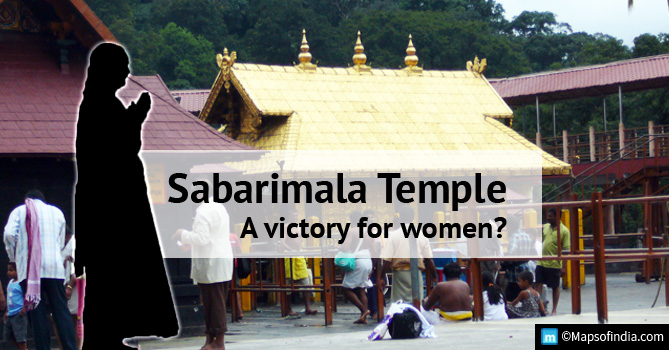
September 2018 has been a month of one after another landmark judgements by the Supreme Court of India. Chief Justice, Dipak Misra, who is set to retire on October 2nd, has so far headed several benches, giving out judgements on some of the highly crucial, not to mention, controversial cases.
In the latest installment of verdicts, the apex court has lifted the ban on women entering the Sabarimala temple of Kerala. While one side of the population has welcomed the decision, calling it an important milestone for equal rights, the other side sees is as a breach by the court into the religion and the faith of its devotees.
The history of Sabarimala issue
While the ban on women from the age group of 10-50, barring their entry into the temple is age-old, the matter wasn’t brought to court till the 1990s. Following a plea in 1990, the High Court of Kerala in 1991 upheld the ban on women’s entry inside the temple.
In 2006, the Sabarimala Temple went into the limelight again, when a Kannada actress-politician claimed she had entered the temple, even touching the feet of the deity in 1987. An official inquiry was also conducted by the crime branch of Kerala government, but was dropped later. So, after 1991, it was 15 years later, in 2006 that the issue reached the doorsteps of our judiciary again. Shortly after, a Public Interest Litigations(PIL) was filed by a group of women’s lawyers, demanding to remove the ban on entry, citing discrimination. This was also supported by the then government of Kerala, LDF.
In 2016, again, a PIL was filed by The India Young Lawyers Association, against the Kerala Hindu Places of Public Worship Rules(1965), which states that “Women who are not by custom and usage allowed to enter a place of public worship shall not be entitled to enter or offer worship in any place of public worship”. The rules were said to be violating the constitutional rights of equality, religious freedom as well as non-discrimination.
What is the verdict?
In a verdict by the five judges bench, led by CJI Dipak Misra, the Supreme Court lifted the ban on women of the said age-group, that earlier forbid them from entering the temple premises. In the 4:1 majority verdict, the ban was seen as an act of gender-discrimination. While the temple authorities were unhappy with the judgement, they said they will be following it.
With the rolling out of this landmark judgement, the Supreme Court made clear in another statement that “biological reasons should not be considered for the continuation of an age-old tradition”. Ironically, however, the only voice of dissent in this verdict came from the only women justice in the panel, Indu Malhotra. According to Malhotra, there is a difference between diversity and discrimination, and hence, the court should not intervene.
Contrasting opinions
The fight for women gaining entry into the Sabarimala temple was going on for decades, before finally coming to an end with the SC judgement. Several people have reacted to the decision with happiness and warm welcome, calling it a victory of women’s rights. However, there are many others who stand on the other side of the boat. Surprisingly, like Justice Malhotra, many of these people protesting the verdict are women themselves.
The women from ‘Ready to wait’ campaign, for example, have come forward with the statement that the ‘SC ignored Ayappan’s rights’. The campaign was started in 2016, with its members declaring that they will wait to turn the ‘right’ age to visit the temple, upholding the religious beliefs. According to the religion, the deity in consideration was a practicing celibate, and accordingly, the entry of women of the age-group 10-50 was forbidden.
Conclusion
As the debate on this topic gets heated up, it is important to look at the arguments that have been put up. According to some people who oppose the judgement, lifting the entry ban will necessarily turn the sacred temple into yet another tourist spot, stripping it off of the sanctity it holds. However, the same people also take pride in the temple’s ‘liberal’ practices that allow people, or rather, males of any social class, caste, or religion to enter the temple. Given their own logic, technically, this ‘liberty’ must also be leading to some sort of an erosion of their faith. However, that is not the case.
While passing on a personal opinion on the issue, one must keep in mind a simple thing. Many women from the faith have already declared that despite the judgement, they will wait till the right age to finally pray inside the temple. The Supreme Court has not taken their right of belief away, it has merely granted it to the other section of the female population. One that perhaps, is equally religious, but has a contrasting opinion. Taking away their right to practice their religion- wouldn’t that be a threat to the faith instead? Just a food for thought.





